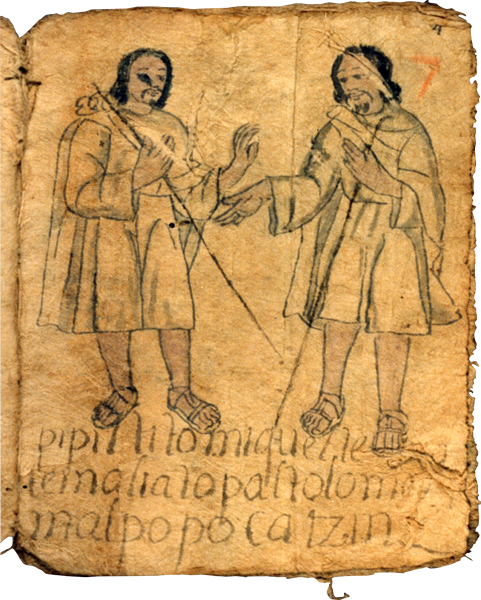Bk. V., f. 4r., two indigenous noblemen standing
This page, which is the front face of the tenth folio of sixteen folios (also Book V, folio 4 recto), shows representations of possible historical personages of early Spanish-colonial Santa María Iztacapan (modern State of Hidalgo, Mexico).
In this scene, two indigenous men are standing, wearing sandals and dressed in knee-length, loose-fitting, white-cotton Spanish-colonial style pants and long-sleeved tunics. The men also wear cloaks tied at the right shoulder over their tunics, a symbol of their high status. The men are outlined in black. Their skin is washed with a flesh-tone watercolor. Their hair reaches to their shoulders and appears to turn under at the bottom. Both men have a pencil-thin mustache and a goatee. Both men are gesturing with their hands, suggestive of some degree of authority. The man on the left also holds a stick that probably represents a staff of office.
The text at the bottom of the page identifies the men as “pipiltin” (nobles), and names them as don Miguel de Santa Maria and don Bartolome Chimalpopocatzin. [SW]
página entera de un folio (pintura y texto)
Esta página, la carátula del décimo de dieciséis folios, muestra las representaciones de posibles personajes históricos de principios del período colonial en Santa María Iztacapan (estado moderno de Hidalgo, México).
En esta escena vemos a dos hombres indígenas de pie, usando sandalias y vestidos con pantalones de algodón blanco hasta las rodillas y túnicas mangas largas. Los hombres visten capas alrededor de su cuello como símbolo de status social alto. Las figuras están delineadas en tinta negra, y pintadas con acuarelas semejantes al color de su piel. Su pelo llega a los hombros y parece ser ondulado. Ambos poseen un bigote fino y una barba en forma de chive. Los hombres están gesticulando con sus manos, sugieriendo cierto grado de autoridad. El hombre de la izquierda sostiene un palo o bastón, y probablemente es un representante del gobierno.
El texto al principio de la página identifica los hombres como “pipiltines” (nobles) y los nombra don Miguel de Santa María y don Bartolomé Chimalpopocatzin
